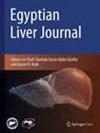Effect of probiotic, prebiotic, and synbiotic supplementation on circadian clock in rats with fructose-induced non-alcoholic fatty liver
IF 0.7
Q4 GASTROENTEROLOGY & HEPATOLOGY
引用次数: 0
Abstract
The rate of NAFLD in the general population is estimated to be 25.2%. NAFLD is affected by lifestyle, diet, and inflammation. In this study, the use of probiotics, prebiotics, and synbiotics was aimed to modulate the circadian clock in the liver and improve metabolic disorder through the gut–liver axis. Six-week-old, healthy, 43 Wistar albino rats were included in the study and their average weight was determined as 140.50 g (95.00–177.00) at the beginning of the study. Before the study, the rats were randomly divided into 5 groups, 8 animals were placed in the 1st, 3rd, 4th, and 5th groups and 11 animals were placed in the 2nd group. Rats in group 1 were fed standard food for 13 weeks. Rats in the 2nd, 3rd, 4th, and 5th groups were fed with 10% fructose water during the 1-week adaptation period and then 20% fructose water. After the 7th week, probiotic treatment (2 × 109 CFU/ml Lactobacillus rhamnosus GG) was administered to rats in group 3rd via gavage for 6 weeks, and prebiotic treatment was administered to rats in group 4th with feed containing 10% grape seed extract. Rats in the 5th group were given a feed consisting of 10% grape seed extract and 2 × 109 CFU/ml Lactobacillus rhamnosus GG via gavage. It was determined that the use of prebiotics as a treatment option in fatty liver had a more positive effect on glucose, ALT, melatonin, and ZO-1 values. In addition, it was observed that synbiotic use had more positive effects on histopathological findings, NAS score, and the expression level of circadian clock genes. While there was no significant difference between the mRNA levels of circadian clock genes, it was observed that gene expression levels increased with fructose consumption and decreased especially with synbiotic treatment. It has been observed that fructose modulates the circadian rhythm by affecting some biochemical and genomic pathways as a result of synbiotic use in order to prevent the negative effects of fructose on fatty liver.补充益生菌、益生菌和合成益生菌对果糖诱发非酒精性脂肪肝大鼠昼夜节律的影响
据估计,非酒精性脂肪肝在普通人群中的发病率为 25.2%。非酒精性脂肪肝受生活方式、饮食和炎症的影响。在这项研究中,使用益生菌、益生元和合成益生菌的目的是调节肝脏的昼夜节律,通过肠肝轴改善代谢紊乱。本研究共纳入了 43 只六周大的健康 Wistar 白化大鼠,研究开始时测定它们的平均体重为 140.50 克(95.00-177.00)。研究开始前,大鼠被随机分为 5 组,8 只大鼠分在第 1、3、4 和 5 组,11 只大鼠分在第 2 组。第 1 组大鼠喂食标准食物 13 周。第 2 组、第 3 组、第 4 组和第 5 组的大鼠在 1 周的适应期内喂食 10% 的果糖水,然后喂食 20% 的果糖水。第 7 周后,给第 3 组大鼠灌胃益生菌治疗(2 × 109 CFU/ml 鼠李糖乳杆菌 GG),为期 6 周;给第 4 组大鼠灌胃益生菌治疗,饲料中含有 10%的葡萄籽提取物。第 5 组大鼠通过灌胃给与含有 10% 葡萄籽提取物和 2 × 109 CFU/ml 鼠李糖乳杆菌 GG 的饲料。结果表明,使用益生元治疗脂肪肝对血糖、谷丙转氨酶、褪黑素和 ZO-1 值有更积极的影响。此外,研究还发现,使用益生元对组织病理学结果、NAS 评分和昼夜节律时钟基因的表达水平有更积极的影响。虽然昼夜节律时钟基因的 mRNA 水平之间没有明显差异,但观察到基因表达水平随果糖摄入量的增加而增加,尤其是在使用益生菌治疗后有所下降。据观察,果糖通过影响某些生化和基因组通路来调节昼夜节律,而使用合生元则可防止果糖对脂肪肝的负面影响。
本文章由计算机程序翻译,如有差异,请以英文原文为准。
求助全文
约1分钟内获得全文
求助全文

 求助内容:
求助内容: 应助结果提醒方式:
应助结果提醒方式:


